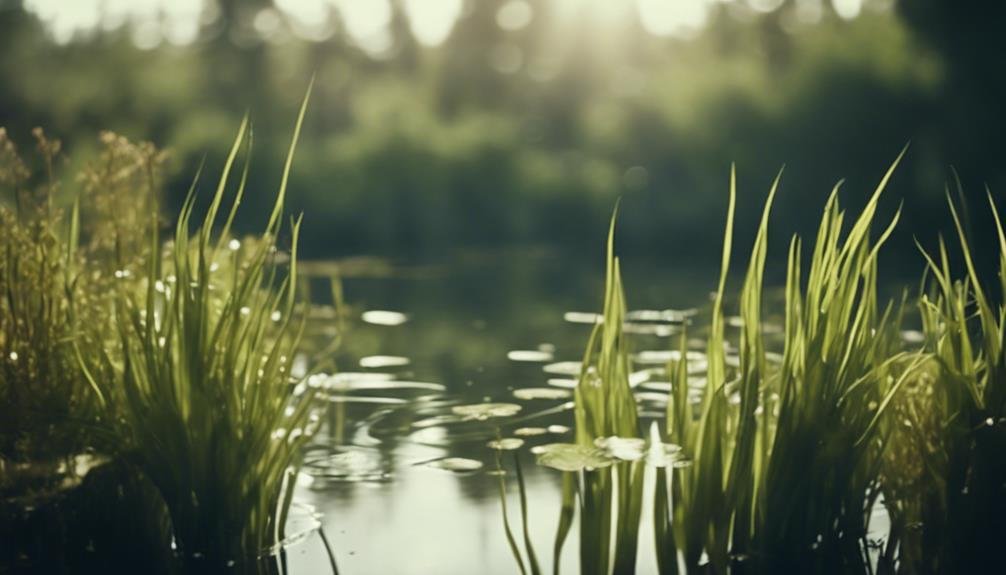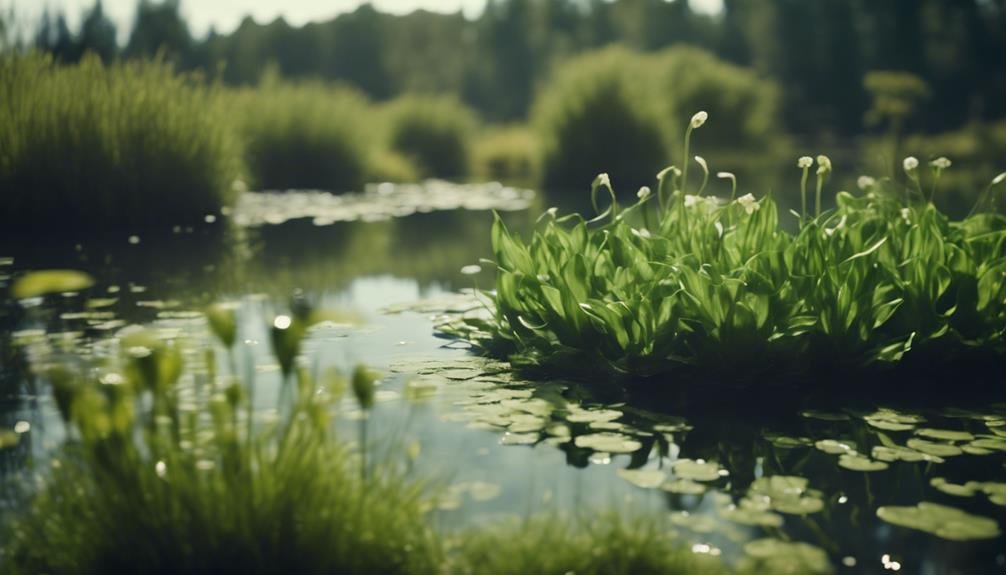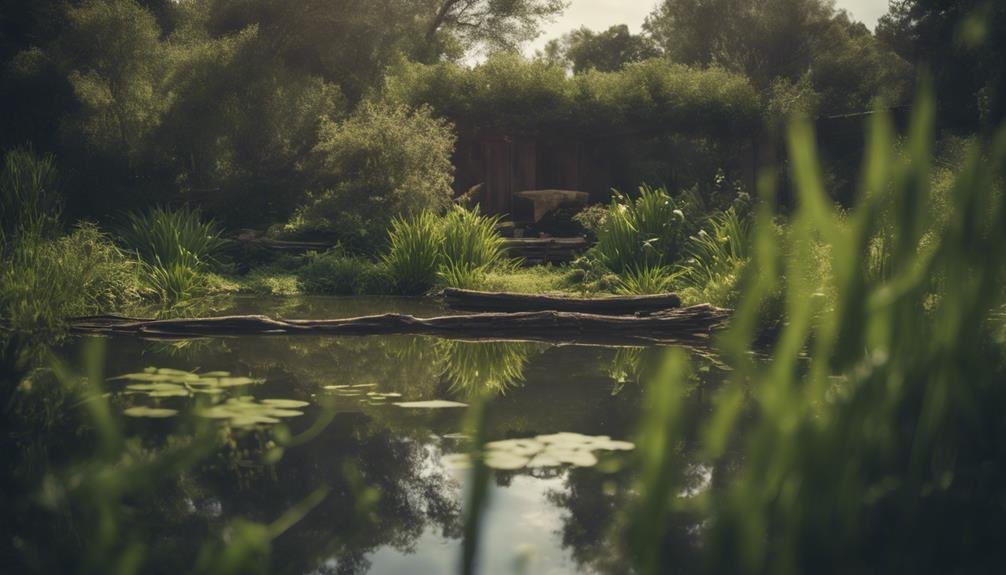Improving pond water quality can be achieved using natural methods such as introducing beneficial bacteria to break down harmful substances like ammonia and nitrites. Stocking plants that absorb excess nutrients and help oxygenate the water is also beneficial.
Aeration systems are essential for maintaining optimal oxygen levels in the pond. Additionally, incorporating algae-eating fish, employing biological pest control techniques, and implementing nutrient balancing practices are effective ways to create a healthy ecosystem.
Proper filtration, sustainable water replenishment, and habitat enhancement play crucial roles in maintaining pristine pond conditions. By combining these strategies, you can establish a thriving and self-sustaining aquatic environment, allowing for further exploration of water quality maintenance measures.
Beneficial Bacteria Boost
Beneficial bacteria play a crucial role in maintaining pond water quality by breaking down harmful substances like ammonia and nitrites into less toxic nitrates, which can be used by plants.
By introducing these microscopic organisms into our ponds, we kickstart the natural purification process, leading to cleaner and healthier water for aquatic life to thrive.
There are various forms of beneficial bacteria available, such as liquid, powder, or tablets. It's essential to carefully follow the manufacturer's instructions when adding them to the pond.
Factors like pond size, fish population, and water quality should be considered to determine the right dosage and frequency of application.
With regular use and proper care, these helpful microbes can significantly improve water clarity, reduce algae growth, and create a more suitable habitat for the fish in our pond.
Plant-Based Water Purifiers
Incorporating aquatic plants strategically can naturally enhance pond water quality in an eco-friendly manner. Certain plant species have purifying capabilities that can help maintain a balanced ecosystem.
Floating plants like water hyacinth and water lettuce are effective at absorbing excess nutrients, which helps prevent algal blooms. Additionally, their roots provide shelter for beneficial bacteria that break down organic matter.
Submerged oxygenators, such as anacharis and hornwort, release oxygen into the water, creating a healthy environment for fish and other aquatic life. These plants also help by consuming nitrates and phosphates, reducing the risk of eutrophication.
Marginal plants, like cattails and iris, positioned along the pond's edges, can filter runoff and offer habitats for various organisms. This integrated approach not only improves water quality but also enhances the overall ecosystem health.
Aeration System Implementation

Let's delve into the world of aeration systems, crucial for maintaining optimal oxygen levels and fostering a thriving pond environment. There are various types of aerators to choose from, each with its own installation nuances and upkeep demands. By selecting and installing the appropriate system thoughtfully, we can significantly improve the water quality and overall health of our pond.
Aeration systems play a vital role in ensuring that ponds have enough oxygen for fish, plants, and beneficial bacteria to thrive. These systems help prevent stagnation, algae blooms, and fish kills by circulating and oxygenating the water. When choosing an aeration system, factors such as pond size, depth, and shape should be considered to determine the most effective solution.
One popular option is the diffused aeration system, which releases tiny air bubbles at the pond's bottom to efficiently distribute oxygen throughout the water column. Another choice is the surface aerator, which agitates the water's surface to enhance gas exchange. Pond owners may also opt for solar-powered aerators for eco-friendly operation or wind-powered aerators for energy efficiency.
Regular maintenance of the aeration system is essential to ensure its smooth operation. This includes cleaning the diffusers or propellers, checking air filters, and monitoring oxygen levels to adjust the system as needed. By investing in a high-quality aeration system and staying proactive with maintenance, we can create a balanced and thriving ecosystem in our pond.
Types of Aerators
When setting up an aeration system in ponds, various types of aerators play a crucial role in enhancing water quality. These aerators are essential for increasing oxygen levels and maintaining a healthy aquatic environment.
One common type of aerator is the surface aerator, which floats on the water's surface and introduces air through mechanisms like propellers or paddle wheels. Ideal for smaller ponds, surface aerators are cost-effective and efficient at oxygenation.
Diffused aeration systems release air bubbles from the pond's bottom, promoting circulation and oxygenation throughout the water column. On the other hand, bottom aeration systems use a different method to distribute air for similar benefits.
Fountain aerators not only aerate the water but also add aesthetic appeal with visually pleasing water displays. Windmill aerators are a sustainable option that utilizes wind power to aerate the pond, offering an eco-friendly solution.
Each type of aerator comes with its own advantages and considerations, requiring careful evaluation based on factors like pond size, depth, and budget. By considering these aspects, it becomes easier to select the most suitable aerator for specific pond needs, ensuring optimal oxygen levels and a thriving aquatic ecosystem.
Installation Considerations
Proper installation is crucial for the efficient operation of an aeration system and to achieve the desired results. Factors such as the size, depth, and shape of the pond must be carefully considered when selecting the right aeration equipment and determining its placement. Following the manufacturer's instructions precisely is essential to ensure the system is installed correctly and safely.
It is also important to take into account the pond's existing ecosystem and make efforts to minimize disruptions to aquatic life during installation. Placing the aerator near the deepest point of the pond is often the most effective way to promote thorough water circulation and oxygenation.
Regular maintenance is key once the system is installed to keep it functioning effectively. This includes cleaning the aerator's components regularly to prevent any buildup or blockages that could hinder its performance. Monitoring the pond's water quality on a regular basis and making necessary adjustments to the aeration system will help maintain optimal conditions for aquatic life and overall pond health.
Maintenance Requirements
Maintaining the effectiveness of your aeration system over the long term is crucial. Regular maintenance is key to ensuring water quality and prolonging the life of your equipment. It's important to take a proactive approach by conducting periodic inspections and cleanings to prevent clogging and ensure peak performance.
Some essential maintenance tasks include:
- Clearing debris from the intake screen and diffuser outlets.
- Checking airline tubing for kinks or leaks and replacing worn sections.
- Cleaning the air pump filter according to the manufacturer's recommendations.
- Inspecting and adjusting the airflow rate as needed to maintain proper circulation.
Neglecting maintenance can result in decreased oxygen transfer, equipment failure, and potential issues like algae blooms or fish kills. By staying on top of these routine tasks, you can extend the lifespan of your system and ensure it continues to operate efficiently.
Establishing a maintenance schedule and sticking to it diligently is vital for the long-term health of your pond ecosystem.
Mechanical Filtration Methods
Mechanical filtration methods are essential for maintaining the cleanliness of pond water by removing floating debris and suspended particles. Two common options for mechanical filtration are surface skimmers and submerged pumps with filters.
Surface skimmers work by collecting floating debris and contaminants from the water's surface. There are two main types: waterfall skimmers and vacuum skimmers. Waterfall skimmers use gravity to direct surface water over a weir into a filter box, making them efficient and low maintenance. On the other hand, vacuum skimmers vacuum water from the surface through a debris-catching filter, allowing for easy installation and customization. However, vacuum skimmers require more frequent filter cleaning compared to waterfall skimmers.
Submerged pumps with filters actively pull water through a mechanical filter, effectively trapping particulates. When choosing a submerged pump system, factors like flow rate, filter media, and self-priming abilities should be considered. While these systems require more maintenance than surface skimmers, they offer comprehensive filtration for pond water.
Both surface skimmers and submerged pumps with filters are crucial in promoting pond health by eliminating organic matter and potential contaminants.
When used in combination with natural treatments, they contribute to maintaining a balanced and thriving ecosystem in ponds.
Natural Algae Control

Algae control is crucial for maintaining a healthy pond environment without resorting to harsh chemicals. One effective method is the introduction of beneficial bacteria that compete with algae for nutrients, creating an environment unfavorable for their growth.
Adding aquatic plants like water lilies or submerged vegetation can also help by shading the water and reducing sunlight available for algal photosynthesis.
Stocking the pond with algae-eating fish such as grass carp or koi is another great strategy. These fish graze on algae, helping to keep the ecosystem balanced.
To manage algae naturally, consider these key factors:
- Nutrient management: Avoid introducing excessive nutrients like phosphates and nitrates that fuel algae growth.
- Aeration: Ensure proper oxygen levels in the water to deter certain types of algae.
- Biological controls: Introduce beneficial microbes, aquatic plants, and algae-eating fish to maintain a healthy balance.
- Physical removal: Regularly skim or rake out algae buildup to prevent overgrowth.
Biological Pest Management
Today, we'll explore various biological pest management methods for maintaining a balanced pond ecosystem. These techniques involve introducing beneficial organisms, boosting predator populations, and using bacterial treatments. By utilizing these natural solutions that target pests, we can reduce the reliance on harsh chemicals, promoting a healthier environment for aquatic life.
Introducing beneficial organisms like ladybugs, lacewings, and predatory mites can help control pest populations effectively. These beneficial insects prey on common pond pests such as mosquitoes, algae, and harmful insects, contributing to a more sustainable ecosystem.
Additionally, enhancing predator populations, such as fish like koi or goldfish, can provide natural pest control by feeding on insects and larvae present in the pond.
Bacterial treatments, such as Bacillus thuringiensis, are another effective biological pest management approach. This naturally occurring bacteria specifically targets mosquito larvae, controlling their population without harming other organisms in the pond.
Beneficial Organisms Introductions
Improving pond water quality naturally involves introducing helpful organisms to manage pests and algae growth. One method is to introduce fish species like Mosquitofish that feed on mosquito larvae and algae, reducing the need for chemical treatments. These fish act as natural pest controllers, maintaining a healthy pond ecosystem.
Another approach is to add beneficial bacteria or microbes that break down organic matter and enhance water clarity. These microbes play a crucial role in decomposing waste and excess nutrients, preventing algal blooms and promoting a balanced ecosystem.
Furthermore, introducing zooplankton such as Daphnia or copepods can help control algae levels by grazing on them. These tiny creatures also serve as a food source for fish, supporting the overall pond food chain.
Consider stocking your pond with these beneficial organisms to maintain water quality and a thriving ecosystem:
- Mosquitofish (Gambusia affinis)
- Daphnia (water fleas)
- Bacillus thuringiensis israelensis (Bti) bacteria
- Copepods (tiny crustaceans)
Predator Population Enhancement
Enhancing predator populations is a key strategy for managing pests in ponds by tapping into nature's own processes. One effective method is introducing predatory fish species like bluegill or largemouth bass, which target insects, larvae, and other organisms that can harm water quality. The gradual introduction of these fish allows the ecosystem to adapt smoothly.
Another approach involves creating conditions that support beneficial insects and invertebrates. Dragonflies, known for their appetite for mosquito larvae, can be encouraged through the development of shallow, vegetated areas that serve as breeding grounds. Additionally, species such as mosquitofish and freshwater shrimp, which consume algae and organic matter, can be introduced to help maintain a healthy balance.
It is crucial to monitor the predator-prey relationship carefully to avoid the risk of overpopulation or depletion of any species. Regular observation and adjustments are necessary to ensure a diverse and self-sustaining aquatic community.
Bacterial Augmentation Approaches
When it comes to maintaining pond water quality, bacterial augmentation offers a natural solution alongside predator introduction. Beneficial bacteria play a crucial role in breaking down organic matter and reducing excess nutrients that can cause algal blooms and poor water clarity. These microorganisms are safe for ponds, fish, and other aquatic life.
There are various methods to introduce beneficial bacteria into ponds. One option is to use commercially available bacterial products specifically designed for this purpose. Another approach is to create compost or manure teas to encourage the growth of beneficial bacteria. Additionally, transferring water and sediment from a healthy established pond can help introduce beneficial microorganisms.
Allowing leaves and organic matter to decompose naturally in the pond also promotes the growth of beneficial bacteria. When using bacterial augmentation, it's essential to carefully follow the instructions provided with the products and regularly monitor water quality. Periodic treatments may be necessary to maintain an optimal bacterial population in the pond.
Nutrient Balancing Techniques

Balancing nutrients is crucial for maintaining a healthy pond environment and preventing excessive algal growth, which can harm aquatic ecosystems by reducing oxygen levels. There are several effective techniques to achieve this balance.
One method is to introduce beneficial bacteria and enzymes that break down excess nutrients, inhibiting algal blooms. These natural additives can be purchased or produced on-site using compost or other organic materials.
Another approach is to manage nutrient inputs by reducing fertilizer runoff from nearby areas and avoiding overfeeding fish or waterfowl. Aquatic plants also play a vital role in absorbing excess nutrients, so maintaining a diverse plant ecosystem is essential.
Additionally, using substances like zeolite or aluminum sulfate can chemically bind and eliminate phosphates, a key nutrient for algae growth. However, it's important to use caution with these methods to avoid impacting water chemistry.
Sustainable Water Replenishment
Replenishing pond water sustainably is crucial for maintaining the long-term health of the ecosystem by minimizing losses from evaporation and seepage. One environmentally friendly method is to collect and divert rainwater runoff into the pond. This not only helps maintain water levels but also introduces essential nutrients.
Another option is to use a well or tap into a municipal water supply, ensuring that the water is treated to remove chlorine and other contaminants.
To reduce the need for frequent water replenishment, consider implementing water-saving strategies. For instance, you can install a pond liner to prevent seepage, cover the pond surface to reduce evaporation, and incorporate water-efficient landscaping around the pond.
Additionally, promoting the growth of aquatic plants that aid in moisture retention can also help conserve water.
Habitat Enhancement Strategies

Enhancing habitats is crucial for promoting a healthy aquatic ecosystem. By incorporating elements like submerged logs, rock piles, and aquatic vegetation, we can create diverse habitats that provide shelter, spawning areas, and food sources for various species. These features attract beneficial wildlife such as fish, amphibians, and invertebrates, contributing to ecological balance.
Strategic placement of plants not only oxygenates the water but also offers hiding spots and nesting materials for wildlife. Establishing shallow areas and gently sloping banks allows sunlight to penetrate, promoting the growth of beneficial microorganisms and serving as nurseries for aquatic creatures. Varying depths and contours create distinct microhabitats, catering to the preferences of different species.
Maintaining a balance between open water and vegetation-rich areas is essential. While open waters promote aeration and prevent stagnation, vegetated zones filter runoff and provide habitat complexity.
Conclusion
While we've discussed various natural ways to improve pond water quality, sometimes the best solution is to step back and let nature take its course. Allowing the pond ecosystem to find its own balance without human interference can lead to a healthier and more sustainable environment.
Sometimes, the key to maintaining clear and clean waters is to simply refrain from unnecessary interventions and let nature thrive on its own terms.

